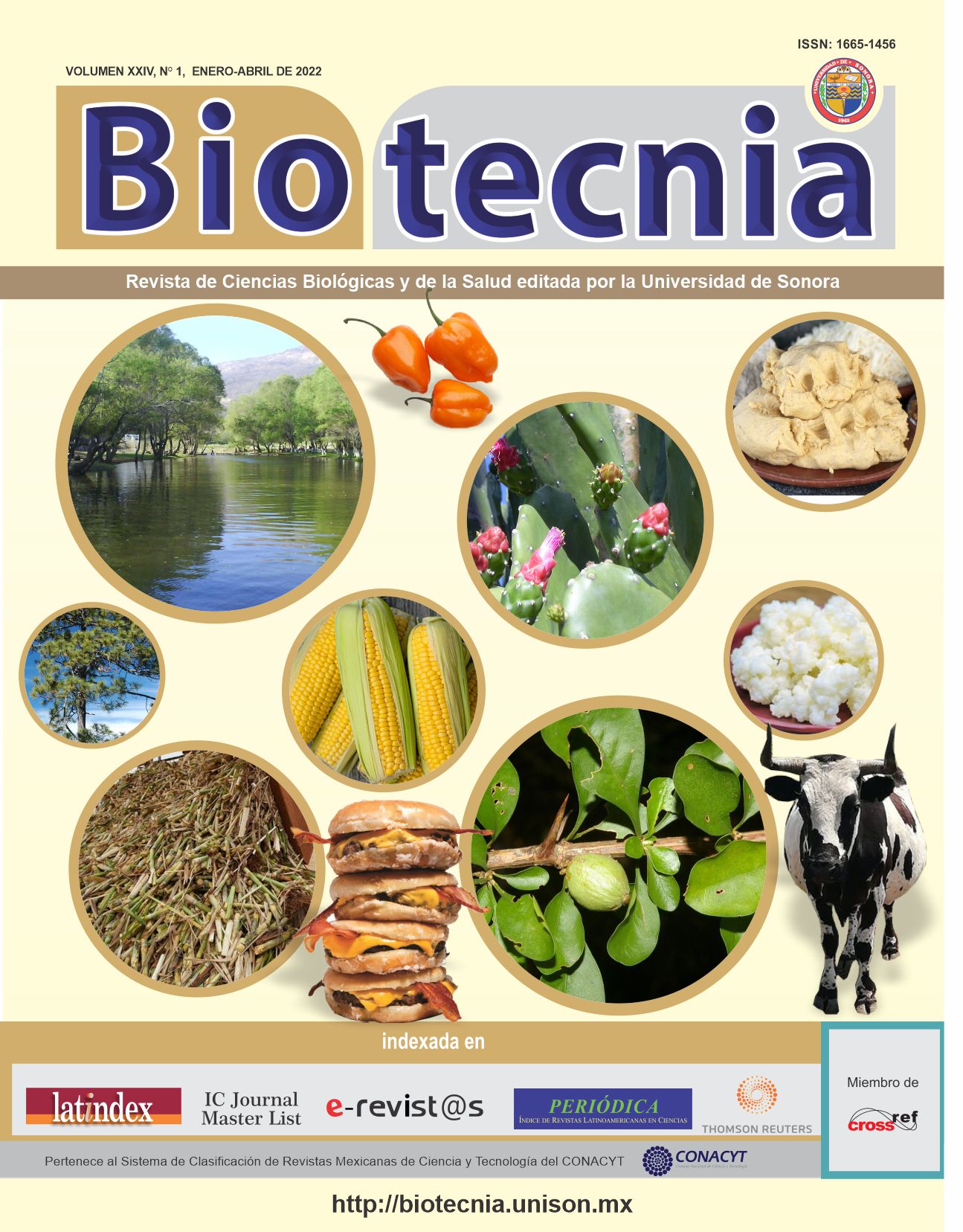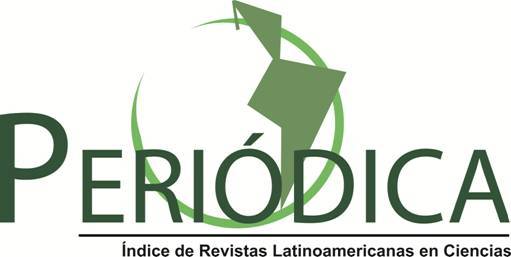Actividad citotóxica in vitro de los extractos de Pinus durangensis Martinez y Quercus sideroxyla Bonpl.
DOI:
https://doi.org/10.18633/biotecnia.v24i1.1520Keywords:
bark extracts, cytotoxicity, phenolic profileAbstract
Nowadays the bioactive compounds from plants represent a great potential for discovering a novel drug that could act in cancer treatment. It has been reported that different species of Pine and oak possess cytotoxic activities against various cancer cell lines. In the present study, we evaluated the phenolic profile and cytotoxic activities of crude and organic extracts from P. durangensis and Q. sideroxyla bark. Some compounds such as taxifolin and procyanidin dimers, were identified in extracts of both species by ESI-MS. The cytotoxic activity was performed on MDA-MB-231(breast cancer), HeLa (cervix cancer), MCF-10A (breast non-tumorous cell) and HSF-1184 (human skin fibroblast cells) by MTT assay. All extracts showed a dose-dependent cytotoxic effect against cancer cell lines and small or no activity against non-tumorous. The results provide important information about cytotoxic activity of bark extracts from P. durangensis and Q. sideroxyla.
Downloads
References
Abdullah, A. S. H., Mohammed A. S., Abdullah R., Mirghani M.E.S., Al-Qubaisi M. 2014. Cytotoxic effects of Mangifera indica L. kernel extract on human breast cancer (MCF-7 and MDA-MB-231 cell lines) and bioactive constituents in the crude extract. BMC Complementary and alternative medicine. 14(1): 1-10.
Alzaharna, M., Alqouqa I., Cheung H. Y. 2017. Taxifolin synergizes Andrographolide-induced cell death by attenuation of autophagy and augmentation of caspase dependent and independent cell death in HeLa cells. PLoS One. 12(2): e0171325.
Amalinei, R. L., Trifan A., Cioanca O., Miron S.D., Mihai C. T., Rotinberg P., Miron A. 2014. Polyphenol-rich extract from Pinus sylvestris L. bark--chemical and antitumor studies. Medical-Surgical Journal, 118(2): 551-557.
Amessis-Ouchemoukh, N., Ouchemoukh S., Meziant N., Idiri Y., Hernanz D., Stinco C. M. 2017. Bioactive metabolites involved in the antioxidant, anticancer and anticalpain activities of Ficus carica L., Ceratonia siliqua L. and Quercus ilex L. extracts. Industrial Crops and Products.95: 6-17.
Anlar, H. G., Bacanli M., Kutluk B., Ahmet, Başaran N. B. 2016. Cytotoxic Activity of Resveratrol in Different Cell Lines Evaluated by MTT and NRU Assays. Turkish Journal of Pharmaceutical Sciences. 13(1): 27-34.
Bermejo, B., Pontones J. B. 1999. Los pinos mexicanos y su utilización como especies introducidas de alto potencial en varios países del mundo. Segundo Simposio sobre Avances en la Producción de Semillas Forestales en América Latina. CATIE. 8:249-253.
Cretu, E., Karonen M., Salminen J. P., Mircea C., Trifan A., Charalambous V., Miron A. 2013. In vitro study on the antioxidant activity of a polyphenol-rich extract from Pinus brutia bark and its fractions. Journal of Medicinal Food. 16(11): 984-991.
De la Luz Cádiz-Gurrea, M., Fernández-Arroyo S., Segura-Carretero A. 2014. Pine bark and green tea concentrated extracts: antioxidant activity and comprehensive characterization of bioactive compounds by HPLC–ESI-QTOF-MS. International Journal of Molecular Sciences. 15(11): 20382-20402
Evacuasiany, E., Ratnawati H., Liana L. K., Widowati W., Maesaroh M., Mozef T., Risdian C. 2014. Cytotoxic and antioxidant activities of catechins in inhibiting the malignancy of breast cancer. Oxididant and Antioxidants in Medical Science. 3(2): 141-146.
Farhan, M., Khan H.Y., Oves M., Al-Harrasi A., Rehmani N., Arif H., Ahmad A. 2016. Cancer therapy by catechins involves redox cycling of copper ions and generation of reactive oxygen species. Toxins, 8(2): 37.
Fernandes, A., Fernandes I., Cruz L., Mateus N., Cabral M., De Freitas V. 2009. Antioxidant and biological properties of bioactive phenolic compounds from Quercus suber L. Journal of Agricultural and Food Chemistry. 57(23): 11154-11160.
Gezer, C., Yücecan S., Rattan S. I. S. 2015. Artichoke compound cynarin differentially affects the survival, growth, and stress response of normal, immortalized, and cancerous human cells. Turkish Journal of Biology. 39(2): 299-305.
Jiménez-Sánchez, C., Lozano-Sánchez J., Gabaldón-Hernández J.A., Segura-Carretero A., Fernández-Gutiérrez A. 2015. RP-HPLC–ESI–QTOF/MS 2 based strategy for the comprehensive metabolite profiling of Sclerocarya birrea (marula) bark. Industrial Crops Products. 71: 214-234.
Karonen, M., Hämäläinen M., Nieminen R., Klika K. D., Loponen J., Ovcharenko V.V., Pihlaja K.2004. Phenolic extractives from the bark of Pinus sylvestris L. and their effects on inflammatory mediators nitric oxide and prostaglandin E2. Journal of Agricultural and Food Chemistry. 52(25): 7532-7540.|
Khosropanah, M. H., Dinarvand A., Nezhadhosseini A., Haghighi A., Hashemi S., Nirouzad F., Dehghani H. 2016. Analysis of the antiproliferative effects of curcumin and nanocurcumin in MDA-MB231 as a breast cancer cell line. Iranian Journal of Pharmaceutical Research. 15(1), 231.
Li, Y. Y., Feng J., Zhang X. L., Li M. Q., Cui Y.Y. 2016. Effects of Pinus massoniana bark extract on the invasion capability of HeLa cells. Journal of Functional. Foods. 24: 520-526.
Lorenz, P., Heinrich M., Garcia-Käufer M., Grunewald F., Messerschmidt V, Herrick A., Steinborn C. 2016. Constituents from oak bark (Quercus robur L.) inhibit degranulation and allergic mediator release from basophils and mast cells in vitro. Journal of Ethnopharmacology. 194: 642-650.
Luna-José, A. D. L., Montalvo-Espinosa L., Rendón-Aguilar B. 2003. Los usos no leñosos de los encinos en México. Boletín de la Sociedad Botánica de México. 72: 107-117.
Mämmelä, P., Savolainen H., Lindroos L., Kangas J., Vartiainen T. 2000. Analysis of oak tannins by liquid chromatography-electrospray ionisation mass spectrometry. Journal of Chromatography A. 891(1): 75-83.
Marvibaigi, M., Amini N., Supriyanto E., Majid F.A.A., Jaganathan S.K., Jamil S., Nasiri R. 2016. Antioxidant Activity and ROS-Dependent Apoptotic Effect of Scurrula ferruginea (Jack) Danser Methanol Extract in Human Breast Cancer Cell MDA-MB-231. PLoS One. 11(7): e0158942.
Moradi, M. T., Karimi A., Alidadi S. 2016. In vitro antiproliferative and apoptosis-inducing activities of crude ethyle alcohole extract of Quercus brantii L. acorn and subsequent fractions. Chinese Journal of Natural Medicines. 14(3): 196-202.
Moreira, L., Araújo I., Costa, Correia-Branco A., Faria A., Martel F., Keating E. 2013. Quercetin and epigallocatechin gallate inhibit glucose uptake and metabolism by breast cancer cells by an estrogen receptor-independent mechanism. Experimental Cell Research. 319(12): 1784-1795.
Moreno-Jiménez, M. R., Trujillo-Esquivel, F., Gallegos-Corona M. A., Reynoso-Camacho M. A., González-Laredo R. F., Gallegos-Infante J. A., Ramos-Gómez M. 2015. Antioxidant, anti-inflammatory and anticarcinogenic activities of edible red oak (Quercus spp.) infusions in rat colon carcinogenesis induced by 1, 2-dimethylhydrazine. Food Chemical Toxicology. 80: 144-153.
Muccilli, V., Cardullo N., Spatafora C., Cunsolo V., Tringali C. 2017. α-Glucosidase inhibition and antioxidant activity of an oenological commercial tannin. Extraction, fractionation and analysis by HPLC/ESI-MS/MS and 1 H NMR. Food Chemistry. 215: 50-60.
Pardo-García, A. I., Martínez-Gil A. M., Cadahía E., Pardo F., Alonso G. I., Salinas M. R. 2014. Oak extract application to grapevines as a plant biostimulant to increase wine polyphenols. Food Research International. 55: 150-160.
Rameshthangam, P. y Chitra, J. P. 2017. Synergistic anticancer effect of green synthesized nickel nanoparticles and quercetin extracted from Ocimum sanctum leaf extract. Journal of Materials Science &. Technology. 34(3): 508-522.
Rosales-Castro, M. y González- Laredo, R. F. 2003. Comparación del contenido de compuestos fenólicos en la corteza de ocho especies de pino. Madera y Bosques, 9: 41-49.
Rosales-Castro, M., Pérez López, M. E., Ponce Rodríguez, M. D. C. 2006. Propiedades antirradicales libres y antibacterianas de extractos de corteza de pino. Madera y Bosques, 12: 37-49.
Rosales-Castro, M., González-Laredo, R. F., Rocha-Guzmán N. E., Gallegos-Infante J. A., Rivas-Arreola, M. J., Karchesy, J. 2012. Antioxidant activity of fractions from Quercus sideroxyla bark and identification of proanthocyanidins by HPLC-DAD and HPLC-MS. Holzforschung. 66: 577-584.
Rosales-Castro, M., González-Laredo, R. F., Rivas-Arreola, M. J., Karchesy, J. 2017. Chemical analysis of polyphenols with antioxidant capacity from Pinus durangensis bark. Journal of Wood Chemistry and Technology. 37(5): 393-404.
Sadeghi-Aliabadi, H., Mosavi H., Mirian M., Kakhki S., Zarghi A. 2012. The Cytotoxic and Synergistic Effects of Flavonoid Derivatives on Doxorubicin Cytotoxicity in Hela, MDA-MB-231, and HT-29 Cancer Cells. Iranian Journal of Toxicology, 5(15): 558-564.
Saenglee, S., Jogloy, S., Patanothai, A., Leid, M., Senawong, T. 2016. Cytotoxic effects of peanut phenolics possessing histone deacetylase inhibitory activity in breast and cervical cancer cell lines. Pharmacological Reports. 68(2): 1102-1110.
Santos, S. A., Villaverde, J. J., Sousa, A. F., Coelho, J. F., Neto, C. P., Silvestre, A. J. 2013. Phenolic composition and antioxidant activity of industrial cork by-products. Industrial Crops and Products. 47: 262-269.
Sarvmeili, N., Jafarian-Dehkordi, A., Zolfaghari, B. 2016. Cytotoxic effects of Pinus eldarica essential oil and extracts on HeLa and MCF-7 cell lines. Research in Pharmaceutical Sciences, 11(6): 476-483.
Şöhretoğlu, D., Sabuncuoğlu, S., Harput, Ü. Ş. 2012. Evaluation of antioxidative, protective effect against H2O2 induced cytotoxicity, and cytotoxic activities of three different Quercus species. Food and Chemical Toxicology. 50(2): 141-146.
Sorice, A., Guerriero E., Volpe M.G., Capone F., La Cara F., Ciliberto G., Costantini S. 2016. Differential Response of Two Human Breast Cancer Cell Lines to the Phenolic Extract from Flaxseed Oil. Molecules. 21(3): 319-337.
Soto-García, M., Rosales-Castro, M., Escalona-Cardoso, G. N., Paniagua-Castro, N. 2016. Evaluation of Hypoglycemic and Genotoxic Effect of Polyphenolic Bark Extract from Quercus sideroxyla. Evidence-Based Complementary and Alternative Medicine. 4032618.
Soto-García, M. y Rosales-Castro M. 2016. Efecto del solvente y de la relación masa/solvente, sobre la extracción de compuestos fenólicos y la capacidad antioxidante de extractos de corteza de Pinus durangensis y Quercus sideroxyla. Maderas. Ciencia y Tecnología, 18: 701-714.
Studzińska-Sroka, E., Piotrowska, H., Kucińska, M., Murias, M., Bylka, W. 2016. Cytotoxic activity of physodic acid and acetone extract from Hypogymnia physodes against breast cancer cell lines. Pharmaceutical Biology. 54(11): 2480-2485.
Yang, I. H., Shin, J. A., Kim, L. H., Kwon, K. H., Cho, S. D. 2016. The caspase 3-dependent apoptotic effect of pycnogenol in human oral squamous cell carcinoma HSC-3 cells. Journal of Clinical Biochemistry and Nutrition. 15-7.
Published
How to Cite
Issue
Section
License
Copyright (c) 2022

This work is licensed under a Creative Commons Attribution-NonCommercial-ShareAlike 4.0 International License.
The journal Biotecnia is licensed under the Attribution-NonCommercial-ShareAlike 4.0 International (CC BY-NC-SA 4.0) license.







_(1)_(1).png)






_(2).jpg)




